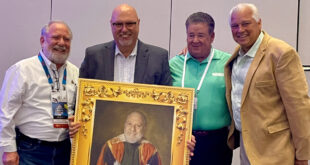
Increasing Productivity
The Field/Office Connection
What is the “secret ingredient” to ensure a successful field workforce? Is it pay, benefits, apprenticeship, mentoring, quality tools and equipment, or maybe communication? This is a question for which companies struggle to find an answer, and one that can make or break the company. Like baking a cake, there are many ingredients to a successful field workforce, and it can be distasteful to leave out any of those ingredients. Over time, I have had the pain and privilege of seeing how an imbalance or implementation of these key components can either drive or derail a company’s labor force. From experience, trial and error, observation, and research, it seems apparent that affirmation, strong leadership, and a strong field office connection in just the right amounts can come together to create the recipe for success.
One of the leading reasons people leave their job is that they do not feel appreciated. Making sure there is a strong sense of appreciation for a company’s fieldworkers is vital to job success. Feeling appreciated is essential to making employees loyal, hardworking, and willing to put in an extra effort. This can be accomplished through wages, profit sharing, awards (monetary or other), company social gatherings, and foremen and office staff alike taking interest in the employees. A contentious relationship between the departments in a company can make it so employees are more likely to leave and less likely to work harder. A company is wise to look at ways to motivate and appreciate the employees who make them successful. Your workforce is your number one resource, and decisions should be made with that in mind. Doing so will create employees who are more likely to stick with the company.
Loyalty and a good work ethic can be enhanced and improved with strong leadership. Management should be vigilant to guard and promote that all employees develop in an environment in which good leadership principles are modeled on a daily basis. There are plenty of leadership concepts that a company can plant its flag upon. John C. Maxwell’s 21 Irrefutable Laws of Leadership is one such model that Rapid Fire Protection has built our foundation upon. Maxwell’s leadership laws are time tested and proven to be very effective principles that can develop the leaders within your company. Without a solid leadership foundation, a company may not be able to withstand economic/ financial hardships of labor fluctuations. Whatever the school of thinking one chooses, it is important a company continually builds the leadership skills of its managers and foremen. Which brings us to the connection between the field and the office.
Most specifically to the fire protection field, a strong field to office connection is essential. When there is communication, encouragement, and accountability throughout the entirety of the project the results are generally positive. A project can lose steam quickly when the project manager gives up and disengages from the project feeling frustrated with the field team. Once this happens, the foreman generally picks up on this disengagement and will in turn adopt a “Why should I care?” attitude. Hopefully, proper leadership and team work between divisions can avoid this situation. If not, it is the job of the labor superintendent to pick up on any indicators of disengagement and call a meeting between the project manager and foreman. He or she can then ensure issues are addressed and that the team is committed to close the project with the best possible results, which brings us back to how to make the field and office work together smoothly.
A field and office connection sounds pretty vague, so what does that look like? Essentially, it is the whole company working as a team and all areas are committed to excellence. It’s surprising how many companies have a huge disconnect between its design/project management team and its installation team. In fact, many companies have cultivated an “us against them” division promoted by foremen and managers. So, how can this be avoided? How can you protect your company from this divisiveness? Below are some steps that will help to prevent this destructive behavior.
1. A job start-up meeting between the foremen and project managers is essential. Some of the items to discuss could include; blueprint clarification, pipe elevations, types of sprinklers and their coverages, phone numbers of the Authority Having Jurisdiction (AHJ) and general contractor, types/sizes of lifts and ladders, date and time of material delivery, forklift arrangements, motel reservations, special labor requirements (Davis-Bacon, prevailing wage, licenses), working hours, etc.
2. The foreman should call in the inventory shorts and back-ordered materials to the project manager.
3. Make sure that any changes or deviations from the original design that is going to be done in the field are discussed with the project manager to see if they are change-order or hydraulic-calculation relevant.
4. A picture of the current highlighted install prints should be emailed to the project manager at the end of each work week. Using highlighters to mark areas of completion on a set of field plans is very beneficial to both the project manager and the installers. This will show the percentage of completion which helps with billings for the project manager. The field crew benefits by having an up-to-date indication of what has been installed and where the loose ends remain. Having the weekly picture taken also helps in the event that a print is damaged or lost; the project manager can re-highlight a copy of the print and get it into the hands of the foreman within a day. Highlighted prints also help with quality control. If you have each installer highlight with their own individual color, then, if there are quality issues (leaks, crooked outlets, improper sprinkler installation), the mistakes can be traced back to the negligent installer for follow-up training.
5. There should also be an end-of-the-week phone conversation between the foreman and project manager to cover the following week’s labor needs and to discuss any installation problems.
6. A quarterly meeting on large projects and midway meeting on small projects between the foreman and project manager is important to assess how the project is tracking and whether the allotted labor hours and materials are tracking to be profitable.
7. A job closeout/completion meeting between the foreman and project manager to discuss any design problems, labor issues, material shortages that caused a hardship to the project. Also, cover some of the procedures and design ideas that stood out as contributors if the project ended profitably.
The more that each team member (be it in the office or the field) performs his/her role and stays within the boundaries of that role, the better the results will be. It is absolutely critical that all members of the team work to make sure your people know they are your most important resource. That means creating an environment of connectivity and affirmation. It also means that the management must strive to model and use strong leadership principles. Finally, it means that the design and installation teams must work together with strong communication and good practices. The end result will be that the field team will begin to grow in trust and loyalty and believe that their contribution is appreciated.
 ABOUT THE AUTHOR: Greg Willson has been involved in the fire protection industry since 1995. He currently is labor superintendent for Rapid Fire Protection, Inc., Rapid City, South Dakota. Willson can be reached via email at gregw@rapidfireinc.com.
ABOUT THE AUTHOR: Greg Willson has been involved in the fire protection industry since 1995. He currently is labor superintendent for Rapid Fire Protection, Inc., Rapid City, South Dakota. Willson can be reached via email at gregw@rapidfireinc.com.

 Sprinkler Age A Publication of the American Fire Sprinkler Association
Sprinkler Age A Publication of the American Fire Sprinkler Association
